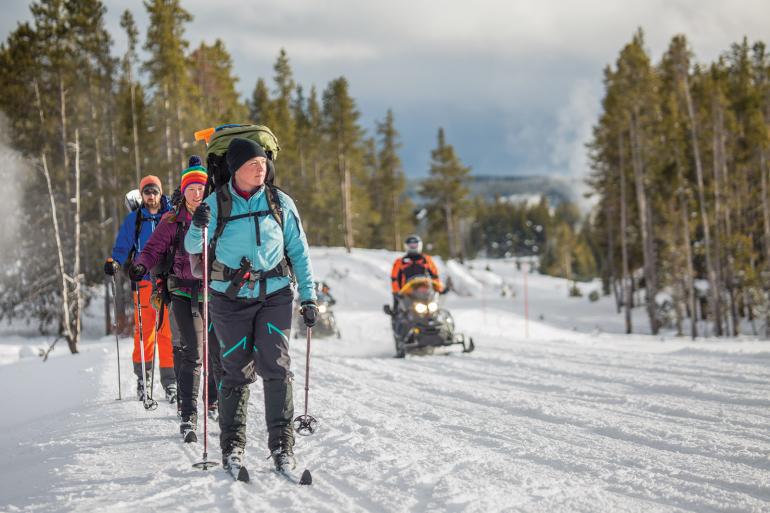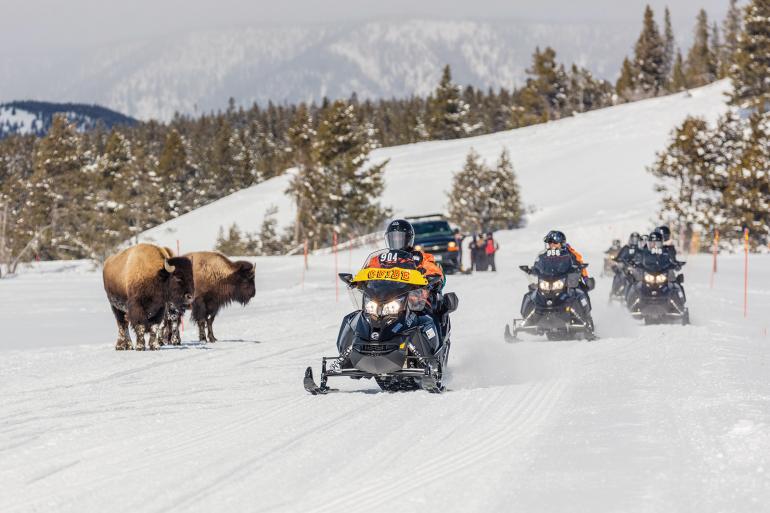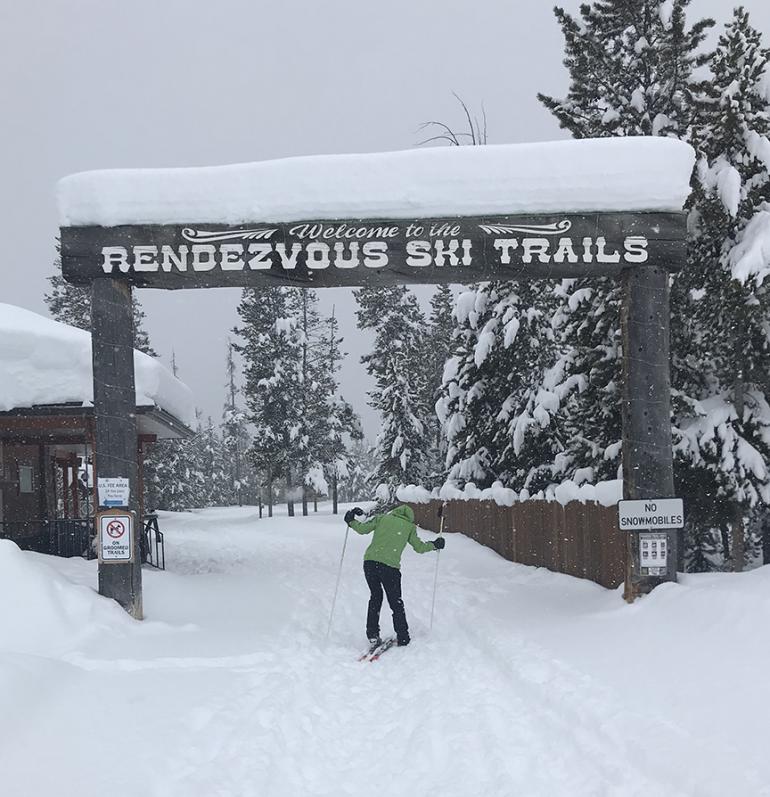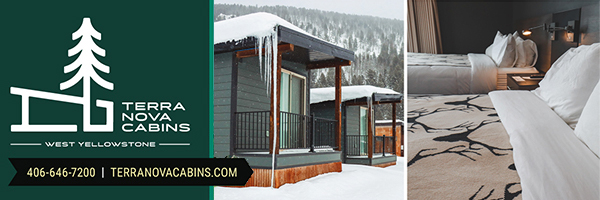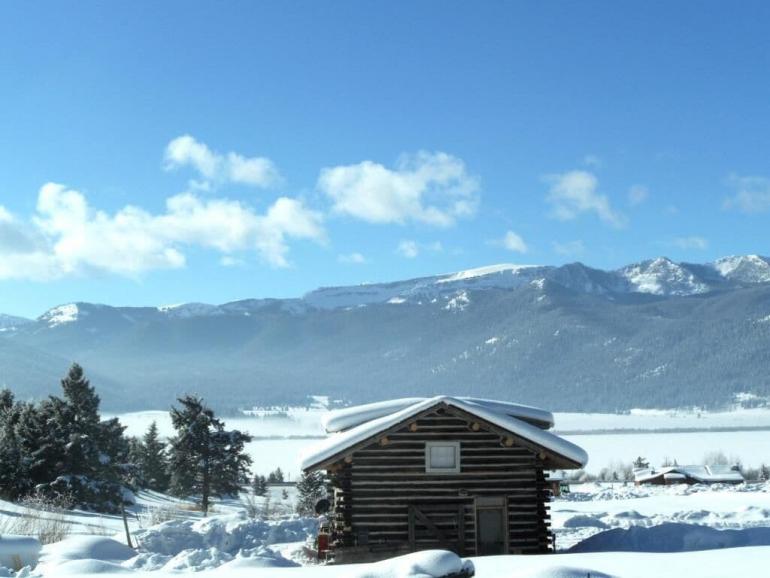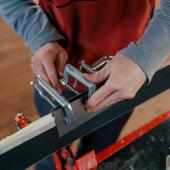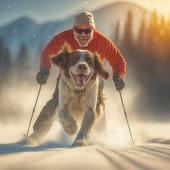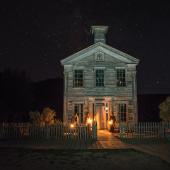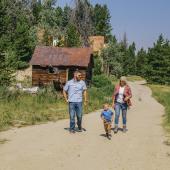Sanctuary City
The white season in West Yellowstone.
Every year, Montana seems to get a little less rugged—bumpy roads are paved over, remote outposts get modern amenities, and comforts increase across the board, eroding the romance of what was once a wide-open land of high adventure. But a few stubborn holdouts remain, where the luxuries of full-scale civilization are held at arm’s length. One of these places is West Yellowstone, which, in wintertime, is still reminiscent of the historic Rocky Mountain West. Roadside snowdrifts higher than your car; sprawling pine forests and picturesque alpine meadows; rustic mountain lodges surrounded by snow-covered glades and gurgling streams; quaint storefronts and hearty steak dinners; smart-aleck bartenders and ornery old shopkeepers; and all around, woodstove smoke rising into the cold alpine air—these are a few of the images that make “West” feel like it’s still part of the frontier. And that’s what keeps people coming back, year after year, to enjoy a weekend or longer in one of Montana’s oldest and most beloved towns. What you may not know, however, is that West isn’t just for sled-heads from Michigan and Minnesota. Indeed, the west entrance to Yellowstone Park makes a mighty fine weekend getaway for dyed-in-the-wool Bozemanites, too.
Yellowstone Park officially opened for the winter in 1971, ushering in the modern era of snowmobiles, snowcoaches, and cross-country skiing. Today, the “white season” in West Yellowstone is almost as popular, and just as important to the local economy, as the summer.
History
In the late 1800s, a trip into Yellowstone was usually by horseback or wagon and required extensive planning and resources. Therefore, visitation to the tiny, unnamed community at the Park’s western gate was limited to a few hardy souls from nearby territories. The arrival of the stagecoach made the trip more tolerable, and visitation began to increase. Eventually, the need for a railroad line became evident. In 1905, an extension of the Oregon Short Line from Ashton, Idaho began, and by the summer of 1908, the first train of visitors arrived at the west entrance on Union Pacific’s “Yellowstone Special.” The town of West Yellowstone sprang up that summer.
The advent of the automobile increased the pace of life in West Yellowstone, and throughout the ensuing decades, the townsite grew rapidly. With more people arriving each summer, new stores and lodges regularly appeared. A temporary slowdown occurred during World War II; but once the war and gas-rationing ended, the town boomed once again. Automobiles soon became the primary mode of transport for West Yellowstone visitors, and after years on the decline, the rail line to West shut down.
Yellowstone Park officially opened for the winter in 1971, ushering in the modern era of snowmobiles, snowcoaches, and cross-country skiing. Today, the “white season” in West Yellowstone is almost as popular, and just as important to the local economy, as the summer.
Activities
In terms of recreation, diversity is probably West’s greatest strength. Outdoor enthusiasts of all flavors find enthusiastic outlets. Self-propelled stylists can strap on skis and explore hundreds of miles of trails, both in the Park and in the surrounding National Forest. On the south edge of town, the Rendezvous Trail system offers 30k of groomed trails for both classic and skate-skiing disciplines. Snowshoeing is another great way to see the surrounding countryside; rentals and maps are available at local shops. Most years, West also maintains an ice rink, so bring your skates along, too.West Yellowstone isn’t known as the snowmobiling capital of the world for nothing—and as of yet, there’s no reason to retract that appellation.
Bundle up and ride along the ice-laden Madison River, then on to Old Faithful and the Norris Geyser Basin, watching herds of buffalo and elk along the way. Beyond that, there are hundreds of miles of trails and open terrain outside the Park. This area offers some of the best, most secluded sledding in the country. Many riders like to spend a leisurely day in the Park watching geysers and wildlife, and another, more aggressive day of powder-riding in the Two Top or Lionhead areas outside of town.
Snowcoach rides offer yet another way to experience the winter wonderland of Yellowstone. They range in size and shape, from Bombardier-style classics to modern vans with specially-designed track conversions. Whatever the style, snowcoaches allow multiple people to travel together in comfort, staying warm on the coldest of days while receiving on-the-fly naturalist and historical commentary from experienced local guides. For this reason, these vehicles have become popular with families and for company outings. Snowcoach rides are also cheaper than renting a snowmobile, and many people enjoy the higher perch for superior wildlife-watching. Most outfits in town let you bring skis along, so you can take a short ski tour through the thermal features around Old Faithful before jumping aboard the snowcoach for the ride back to town.
West Yellowstone also makes a great basecamp for day-trips into the surrounding area. Downhill skiing at Big Sky is just a 45-minute drive to the north, while Jackson Hole and Grand Targhee are less than two hours to the southeast. Backcountry skiing abounds in the nearby mountains. Ice-fishing at Hebgen Lake is a short jaunt to the northwest. If you’re worn out and need a day of milling about, poke around Island Park, just a few minutes’ drive to the southwest.
Indoors
Don’t think you have to spend every waking moment outside—there are numerous indoor activities to keep you busy when your legs are sore from skiing or when it’s just too darn cold to go outside. The Grizzly & Wolf Discovery Center has live bears and wolves as well as educational exhibits, naturalist presentations, and a well-stocked gift shop.
The Yellowstone Giant Screen features a six-story screen and 12,000 watts of surround-sound—after that sensory experience, you’ll have a hard time going back to those tinny YouTube videos on your smartphone. Musical comedies play six nights a week at the Playmill Theatre, while Big Gun Fun offers a variety of firearms, including fully automatic rifles, to shoot at their indoor range. A museum, scores of eateries, and various shops round out the indoor experience in West.
Future
The pandemic, Montana being “discovered,” and an increasing national population mean that Yellowstone Park visitation will likely keep increasing—and that West Yellowstone will keep feeling the pressure to adapt. But for now, it’s still pleasantly homespun, especially when compared to its glitzy neighbor to the north. Whatever the future holds for West, one thing’s for sure: the town that popped up in 1908 will still be there in 2028, and in the years and decades thereafter. And its lazy, snow-covered streets will be a welcome respite from the ever-increasing hustle and bustle of luxurious Boz Angeles.
Editor's note: If you're looking for a quiet getaway while in West Yellowstone, consider the Johnson Creek Cabin, on the north shore of Hebgen Lake. It's got all the necessary amenities, plus a roaring woodstove and stunning views of the Henry's Lake Mountains. It's just a short drive into town for groceries, dining, ice skating, skiing on the Rendezvous trails, and anything else you might need.

